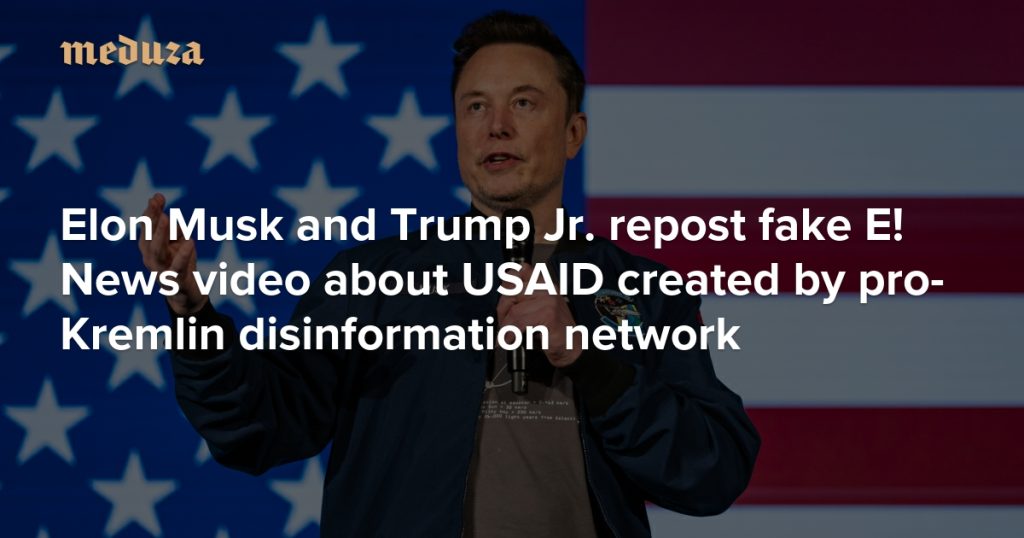Musk, Trump Jr. Amplify Russian Disinformation Targeting USAID and Celebrity Ukraine Visits
In a concerning incident highlighting the vulnerability of online platforms to disinformation campaigns, billionaire Elon Musk and Donald Trump Jr. recently shared a fabricated video originating from a known Russian disinformation network. The video falsely alleged that the U.S. Agency for International Development (USAID) funded celebrity trips to Ukraine, portraying these visits as a calculated PR stunt to bolster President Zelenskyy’s image. This incident underscores the insidious nature of disinformation and the ease with which it can be disseminated, even by prominent figures, reaching millions of viewers and potentially shaping public opinion.
The video, initially posted by Russia’s Matryoshka disinformation network, was quickly amplified by Musk and Trump Jr. on X (formerly Twitter). It claimed that USAID spent millions of dollars to send celebrities, including Angelina Jolie, Sean Penn, Ben Stiller, Orlando Bloom, and Jean-Claude Van Damme, to Ukraine following Russia’s full-scale invasion. The video, designed to mimic a segment from the U.S. entertainment news outlet E! News, presented fabricated figures for the alleged payments to each celebrity, linking these supposed expenditures to a scheme to enhance Zelenskyy’s popularity, particularly within the United States.
E! News has categorically denied any involvement in the video’s creation, confirming its fraudulent nature. Ben Stiller, one of the celebrities targeted in the video, vehemently refuted the claims, stating that he personally funded his humanitarian trip to Ukraine and received no financial support from USAID. This direct rebuttal from Stiller exposes the video’s falsity and highlights the potential damage such disinformation can inflict on individuals and organizations.
The rapid spread of the video, garnering over 3.8 million views, demonstrates the effectiveness of disinformation campaigns in exploiting the virality of social media platforms. According to Bot Blocker, a tracking project monitoring online bot activity, the video is part of a broader Kremlin-orchestrated campaign aimed at discrediting USAID. This revelation places the incident within a larger context of Russian disinformation efforts targeting Western institutions and narratives surrounding the war in Ukraine.
The incident involving Musk and Trump Jr. raises critical questions about the responsibility of social media platforms in combating the spread of disinformation. While platforms like X have implemented measures to counter fake news, the ease with which this video circulated demonstrates the ongoing challenges in effectively curbing the spread of malicious content. The incident also underscores the importance of media literacy and critical thinking in navigating the online information landscape. Users must be vigilant in scrutinizing information, particularly when it originates from questionable sources or aligns with pre-existing biases.
This incident serves as a potent reminder of the insidious nature of disinformation in the digital age. The fabricated video, amplified by influential figures, effectively weaponized celebrity visits to Ukraine, twisting humanitarian efforts into a narrative of political manipulation. The case underscores the need for ongoing vigilance in identifying and countering disinformation campaigns, as well as the importance of critical thinking in navigating the complexities of online information. The incident’s repercussions extend beyond the immediate targets, potentially eroding public trust in humanitarian aid organizations and further polarizing discourse surrounding the war in Ukraine. The amplification of this disinformation by Musk and Trump Jr., individuals with substantial online reach, highlights the potential for such campaigns to manipulate public perception and sow discord on a significant scale. Furthermore, it underscores the imperative for social media platforms to refine their mechanisms for identifying and mitigating the spread of harmful content, particularly when originating from known disinformation networks.


